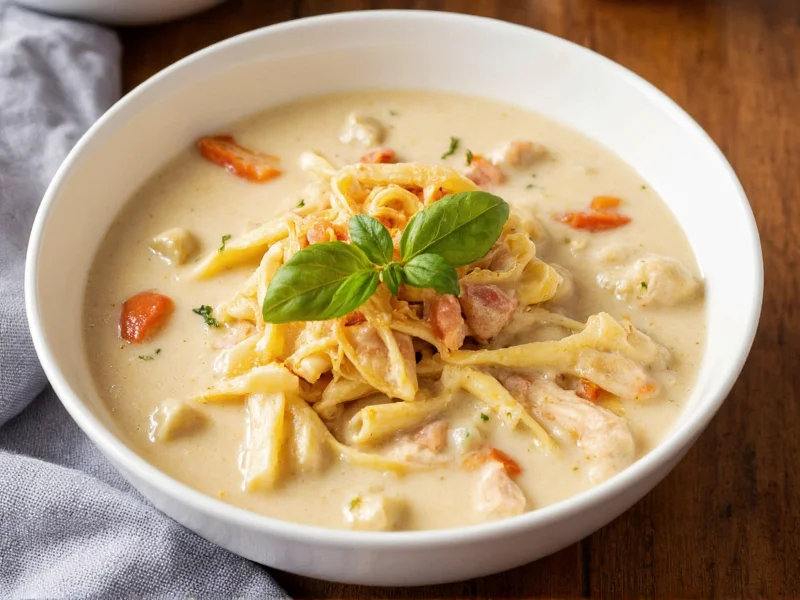Creating the perfect white chicken lasagna soup requires understanding the balance between rich creaminess and comforting pasta elements. Unlike traditional tomato-based chicken soup, this version features a velvety white sauce that coats tender chicken pieces and small pasta shapes, creating a satisfying meal that's become increasingly popular among home cooks seeking Italian-inspired comfort food.
Why White Chicken Lasagna Soup Stands Out
What distinguishes this recipe from other chicken soups is its clever adaptation of lasagna components into soup form. Instead of layered noodles and cheese, the soup incorporates broken lasagna noodles that absorb the flavorful broth while maintaining texture. The "white" designation comes from the creamy base rather than tomato sauce, featuring ingredients like:
- Freshly grated Parmesan cheese
- Ricotta or cream cheese for richness
- Garlic and onion for aromatic depth
- Spinach or kale for color contrast
Essential Ingredients for Authentic Flavor
The magic of a perfect white chicken lasagna soup recipe lies in ingredient quality and proper technique. For the best results when making white chicken lasagna soup from scratch, consider these component breakdowns:
| Ingredient Category | Recommended Options | Why It Matters |
|---|---|---|
| Chicken | Rotisserie chicken, poached breast, or thigh meat | Shredded texture holds up better than diced in soup |
| Pasta | Lasagna noodles broken into 1-inch pieces | Releases starch gradually for ideal thickness |
| Cream Base | Half-and-half with cornstarch or evaporated milk | Prevents curdling while maintaining richness |
| Flavor Builders | Fresh garlic, onion, Italian seasoning blend | Creates layered flavor foundation |
Step-by-Step Preparation Guide
Follow these steps for a foolproof white chicken lasagna soup with ricotta that maintains perfect texture and flavor balance:
- Sauté aromatics: Cook onions and garlic in olive oil until translucent (about 5 minutes)
- Create roux: Add flour to form paste, cooking 2 minutes to eliminate raw flour taste
- Build broth: Gradually whisk in chicken broth, then add milk/cream mixture
- Add seasonings: Stir in Italian herbs, salt, pepper, and red pepper flakes
- Incorporate pasta: Add broken lasagna noodles and simmer 12-15 minutes until al dente
- Add proteins: Fold in shredded chicken and spinach until wilted
- Finish with cheese: Remove from heat before adding Parmesan and ricotta to prevent curdling
Common Variations for Dietary Preferences
Adapt this versatile recipe to suit different needs while maintaining the essence of white chicken lasagna soup:
- Gluten-free version: Substitute gluten-free lasagna noodles and use cornstarch instead of flour
- Lighter option: Use evaporated milk instead of heavy cream for healthy white chicken lasagna soup
- Vegetarian adaptation: Replace chicken broth with vegetable broth and omit chicken
- Extra protein boost: Add white beans for additional fiber and protein
Troubleshooting Common Issues
Even experienced cooks encounter challenges with creamy soups. Here's how to solve frequent problems when making white chicken lasagna soup:
- Curdling: Always temper dairy by adding warm broth gradually before incorporating into soup
- Too thick: Add additional broth ¼ cup at a time until desired consistency
- Pasta overcooking: Cook noodles separately and add at the end for meal prep versions
- Flavor imbalance: Brighten with lemon juice or additional herbs if too rich
Serving and Storage Recommendations
Maximize enjoyment of your white chicken lasagna soup with these professional tips:
- Serve immediately with fresh basil garnish and extra Parmesan
- Store in airtight containers for up to 4 days in refrigerator
- Freeze without dairy components, adding cream when reheating
- Reheat gently over medium-low heat to prevent separation
- Consider doubling the recipe for easy freezer meals
Frequently Asked Questions
Can I use regular lasagna noodles in soup?
Yes, but break regular lasagna noodles into 1-inch pieces before adding to the soup. Fresh lasagna sheets work best as they cook more evenly, but dried noodles require slightly longer simmering time. For best texture, add noodles when broth reaches a gentle simmer rather than full boil.
How do I prevent the cream from curdling?
To prevent curdling in white chicken lasagna soup without heavy cream issues, always temper dairy components. Remove soup from direct heat, ladle ½ cup of hot broth into a separate bowl, gradually whisk in your cream or milk, then slowly incorporate back into the main pot. Avoid boiling after adding dairy, and maintain temperature below 180°F (82°C).
What's the best way to reheat frozen soup?
Thaw frozen white chicken lasagna soup overnight in the refrigerator before reheating. Gently warm over medium-low heat, stirring frequently. If the soup separated during freezing, whisk in 1-2 tablespoons of cold milk while reheating. For best results with make-ahead versions, freeze without dairy components and add cream when reheating.
Can I make this soup in a slow cooker?
Yes, you can adapt this recipe for slow cooker preparation. Sauté aromatics first, then transfer to slow cooker with broth and seasonings. Cook on low for 4 hours, add noodles and chicken during last 30 minutes, then stir in dairy components after turning off heat. This method creates exceptionally tender chicken but requires careful timing with pasta to prevent mushiness.











 浙公网安备
33010002000092号
浙公网安备
33010002000092号 浙B2-20120091-4
浙B2-20120091-4